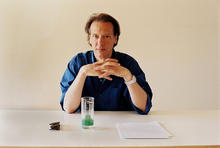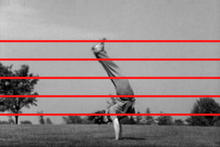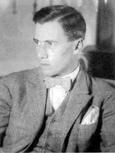Video Quartet
(2002)by Christian Marclay is a visual and sonic collage that explores a kind of collective film memory, using extracts from well-known Hollywood movies, with an overlaid, sampled soundtrack.
Of its first presentation in the US, New York Times art critic Roberta Smith exclaimed, "Christian Marclay has never brought music, sound and image into such perfect, beautiful, funny alignment, nor conflated seeing and hearing so ecstatically…..no amount of naming names, identifying individual movies or describing scenes can account for the work's delicious, fast-paced flow". For this work, Christian Marclay collected thousands of Hollywood movie clips featuring images of hands on keyboards, horns and violins, as well as men and women singing, dancing and engaging in various other acts of making noise. Using a standard laptop-editing programme, he then choreographed the unaltered snippets into a dazzling dramaturgical flow. The resulting work is a seventeen-minute, four-screen DVD projection that brilliantly conflates levels of the real and the artificial from Jimi Hendrix in concert to Elvis in Jailhouse Rock, and syncopates explosions and pratfalls, lines up trumpeters, pairs piano-players, and strings together movie screams culminating in Maria Callas' famous high C. Video Quartet is a tour de force, an erudite yet highly spirited sampling of the history of music in film and film in music, from a master of the mix.
Source: White Cube
Christian Marclay has carefully selected and synchronised the clips in Video Quartet, retaining their original music in order to develop a singular musical score. The video begins with extracts of orchestras tuning up and builds into a crescendo and a cacophony of sound before slowing to a passage of calm. Numerous film-star moments seem to represent the breadth of recent movie history. Many of the clips appear to be selected for their musical content, and show instances in a film when music moves beyond the background score and becomes integral to the story. At other times the noises we hear are likely to have been produced as sound effects and appear to be made by objects such as telephones ringing or doors slamming.
Since 1979 Marclay has made artworks that reflect his fascination with music. Developing his own forms of audio-visual sampling, he has made sculptures, conceptual works and videos. His works often incorporate familiar found materials, from record covers to film clips, which he meticulously pieces together.
Source: Tate Modern
Christian Marclay’s four-screen installation Video Quartet, 2002, is undoubtedly his most accomplished example of audiovisual fusion to date. Facilitated by his forays into desktop video technology but with a clarity of focus that lets us forget the technology of how it was made, Video Quartet immerses the audience in a rapid-fire collage of Hollywood film-clips that feature actors and musicians playing instruments or making sound. On four contiguous screens are projected distinct montages of film clips that Marclay sampled along with their original sound tracks making, making for a richly layered, orchestral experience that recontextualizes iconic images from the history of cinema. The complex narrative blurs the line between musical and visual structure, combining the disparate fragments in a way that resonates deeply with contemporary media-saturated life.
Source: Bombsite








